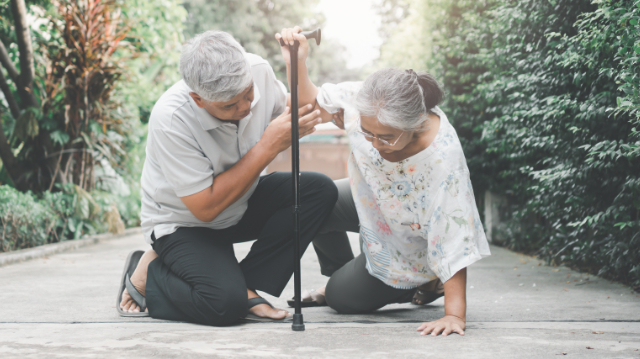Health Blog: Solutions & Wellness Tips
Falls Can Have Dire Consequences And Major Costs For Older Adults

Although falls in older adults are responsible for nearly one million hospitalizations and tens of billions of dollars in healthcare spending, many people are not properly informed about the scope of the problem or what they can do to address it. This is the impetus behind Fall Prevention Month, which is a campaign put forth every September that’s intended to boost awareness about the many dangers of falling with educational resources and guidance on what can be done to manage this risk.
To do our part towards these efforts, each of our posts this month will focus on a different aspect of falls in seniors and how they can be prevented.
Eye–opening facts about falls in older adults
Falls are alarmingly common in Americans over the age of 65 years. Here are a few facts to help you better understand the extent of the issue:
- One out of every three adults over the age of 65 and one of every two adults over 85 will fall at least once each year
- Approximately 2.8 million older adults visit the ER, 800,000 are hospitalized, and 27,000 die each year because of a fall
- This makes falls the leading cause of fatal injuries, non–fatal injuries, and hospitalizations in the population over 65
- The death rate associated with falls for seniors increased by 30% from 2007 to 2016
- Falls are among the 20 most expensive medical conditions in the U.S., with the yearly costs of fall–related injuries estimated to be about $50 billion
- About 20–30% of falls cause moderate to severe injuries that have a significant impact on one’s functional mobility and independence
Falls can occur for a variety of reasons, but they are often due to a combination of internal and external factors. Although age certainly contributes to fall risk, health status is a far more accurate predictor of one’s individual risk. Health conditions like arthritis, balance problems, lower body weakness, dementia, diabetes, and impaired vision or hearing all become increasingly common in older age and can make falls more likely. Taking numerous medications—some of which can impair balance or have other dangerous side effects—can further elevate the risk for falls.
A person’s external environment, particularly their home, is also a big determining factor in one’s fall risk. Loose rugs, clutter, slippery surfaces, poor lighting, steep or uneven stairs, and a lack of handrails or grab bars can all pose significant dangers for older adults—especially those who also have many internal, health–related risk factors. These hazards are common in many homes if no guidance is provided on how to avoid them, and this is why so many falls (up to 50%) are related to environmental causes. Collectively, the more internal and external risk factors that are present, the greater the likelihood that the individual will experience a fall.
Common consequences of falls
Fractures are by far the most serious consequence of falls, with hip fractures occurring most frequently and posing the biggest threat to older adults. In the senior community, an astonishing 95% of hip fractures are caused by falls, and more than 300,000 adults over the age of 65 are hospitalized for this type of injury every year. Other common fractures include the spine, arm, forearm, leg and ankle, and the risk for these increases even more when osteoporosis—also common in older adults—is present.
Hip fractures are particularly devastating because of their impact on mobility, as many older adults struggle to recover or regain their prior level of function afterwards. Surgery is also needed for many patients, which is associated with additional risks. Sadly, older adults have a 27% chance of dying within one year if they suffer from a hip fracture.
If a fall does occur, many individuals go on to develop an even greater fear of falling, even if they’re not injured. This can cause them to limit their activities, which leads to reduced mobility and loss of physical fitness. Worst of all, this process can develop into a vicious cycle that further raises the risk for falling because of these changes.
In our next post, we’ll talk about the importance of exercise and why it should serve as a key force for preventing falls in older adults.
September 7, 2021
Back to Health BlogRECENT POSTS
- Easing the Burden of Tension Headaches With Physical Therapy
- Got Heel Pain? New Study Reveals How to Outsmart Plantar Fasciitis
- How Physical Therapy Can Tame Whiplash-Related Symptoms
- Exercise Therapy May Provide Relief for Chemotherapy-Related Issues
- Unlocking Relief From Elbow Pain With Hands-On Therapy and Exercise
- Are Deep Squats Really as Bad as We Think?
- Reclaiming Your Grip: The Power of Hands-On Therapy for Tennis Elbow
- Runners Can Overcome a Common Knee Condition With Physical Therapy
- How Physical Therapy Can Help Older Adults Stay on Their Feet
- What You Need to Know About Alcohol and Heart Health
